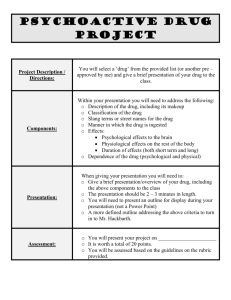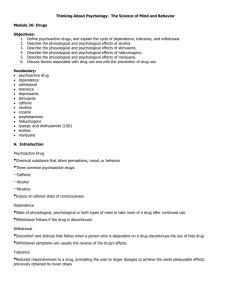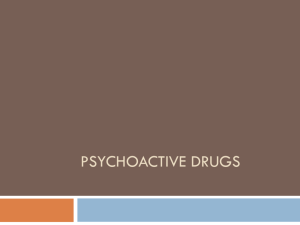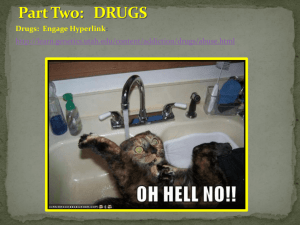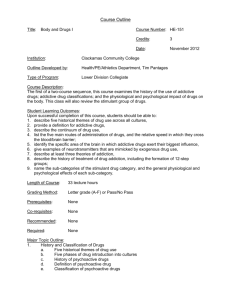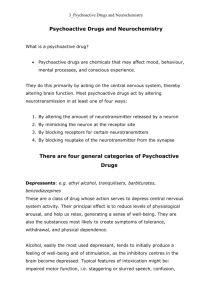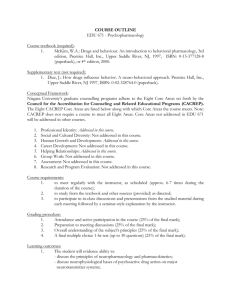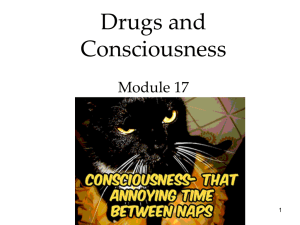TAP3_LecturePowerPointSlides_Module09
advertisement
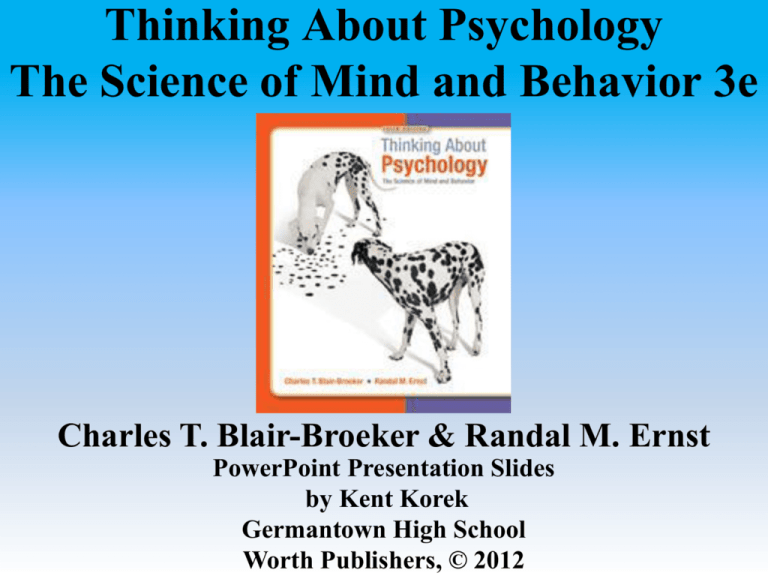
Thinking About Psychology The Science of Mind and Behavior 3e Charles T. Blair-Broeker & Randal M. Ernst PowerPoint Presentation Slides by Kent Korek Germantown High School Worth Publishers, © 2012 Biopsychology Domain Consciousness Module 09 Psychoactive Drugs Module Overview • • • • • • What Are Psychoactive Drugs? Alcohol: A Depressant Stimulants Hallucinogens Marijuana Prevention Click on the any of the above hyperlinks to go to that section in the presentation. Module 09: Psychoactive Drugs What Are Psychoactive Drugs? Psychoactive Drug • Chemical substance that alters perceptions, mood, or behavior. • Three common psychoactive drugs: – Caffeine – Alcohol – Nicotine • Induce an altered state of consciousness Dependence • State of physiological or psychological need (or combined need) to take more of a drug after continued use. • Withdrawal follows if the drug is discontinued Withdrawal • Discomfort and distress that follow when a person who is dependent on a drug discontinues the use of that drug. • Withdrawal symptoms are usually the reverse of the drug’s effects. Tolerance • Reduced responsiveness to a drug, prompting the user to larger dosages to achieve the same pleasurable effects previously obtained by smaller doses. Tolerance Types of Psychoactive Drugs • • • • Depressants Stimulants Hallucinogens Marijuana Module 09: Psychoactive Drugs Alcohol: A Depressant Depressants • Drugs (such as alcohol and sedatives) that reduce neural activity and slow body functions. Alcohol (ethyl alcohol) • Found in beer, wine, and liquor • The second most used psychoactive drug (caffeine first) • Slows thinking, and impairs physical activity Blood Alcohol Content (BAC) • A measure of how much alcohol is in a person’s bloodstream • BAC of .08 considered legal intoxication in most states Euphoric Affects of Alcohol • Alcohol impairs the parts of the brain responsible for controlling inhibitions and making judgments Alcohol, Memory, and Sleep • Studies have shown that alcohol impairs memory by suppressing the processing of events into long term memory. • Alcohol impairs REM sleep, further disrupting memory storage. Alcoholism Module 09: Psychoactive Drugs Stimulants Stimulants • Drugs (such as caffeine, nicotine, and the more powerful amphetamines and cocaine) that excite neural activity and speed up body functions. Caffeine • Stimulant found in coffee, chocolate, tea, and some soft drinks. • Provides user with a sense of increased energy, mental alertness, and forced wakefulness • Blocks neurological receptor sites that, if activated, sedate the central nervous system Nicotine • Stimulant found in tobacco. • Effects similar to those of caffeine • Very addictive and does not stay in the body very long Cocaine • Stimulant derived from the leaves of the coca plant. • Crack – cocaine crystals • Blocks the reuptake of certain neurotransmitters • Dependency is quick and severe; places extreme strain on cardiovascular system Amphetamines • Drugs that stimulate neural activity, speeding up body functions. • Include increased energy and mood changes • Includes: speed, uppers, and methamphetamines • Mimic adrenaline • Can cause irreversible changes in mood Ecstasy • Also called MDMA, this hallucinogenic stimulant produces lower inhibitions, pleasant feelings, and greater acceptance of others. • Even moderate users may experience permanent brain damage. Module 09: Psychoactive Drugs Hallucinogens Hallucinogens • Psychedelic (mind-manifesting) drugs, such as LSD, that distort perceptions and • evoke sensory images in the absence of sensory input. Lysergic Acid Diethylamide (LSD) • Powerful hallucinogenic drug; also known as acid. • The effects vary from person to person • Users can be dangerous to themselves and others. Module 09: Psychoactive Drugs Marijuana Marijuana • Leaves, stems, resin, and flowers form the hemp plant that, when smoked, lower inhibitions and produce feelings of relaxation and mild euphoria. • THC (delta-9-tetrahydrocannabinol) is the active ingredient • Disrupts memory; lung damage from smoke Module 09: Psychoactive Drugs Prevention A Guide to Selected Psychoactive Drugs High School Drug Use The End Teacher Information • Types of Files – This presentation has been saved as a “basic” Powerpoint file. While this file format placed a few limitations on the presentation, it insured the file would be compatible with the many versions of Powerpoint teachers use. To add functionality to the presentation, teachers may want to save the file for their specific version of Powerpoint. • Animation – Once again, to insure compatibility with all versions of Powerpoint, none of the slides are animated. To increase student interest, it is suggested teachers animate the slides wherever possible. • Adding slides to this presentation – Teachers are encouraged to adapt this presentation to their personal teaching style. To help keep a sense of continuity, blank slides which can be copied and pasted to a specific location in the presentation follow this “Teacher Information” section. Teacher Information • Domain Coding – Just as the textbook is organized around the APA National Standards, these Powerpoints are coded to those same standards. Included at the top of almost every slide is a small stripe, color coded to the APA National Standards. • Scientific Inquiry Domain • Biopsychology Domain • Development and Learning Domain • Social Context Domain • Cognition Domain • Individual Variation Domain • Applications of Psychological Science Domain • Key Terms and Definitions in Red – To emphasize their importance, all key terms from the text and their definitions are printed in red. To maintain consistency, the definitions on the Powerpoint slides are identical to those in the textbook. Teacher Information • Hyperlink Slides - Immediately after the unit title slide, a page (usually slide #4 or #5) can be found listing all of the module’s subsections. While in slide show mode, clicking on any of these hyperlinks will take the user directly to the beginning of that subsection. This allows teachers quick access to each subsection. • Continuity slides - Throughout this presentations there are slides, usually of graphics or tables, that build on one another. These are included for three purposes. • By presenting information in small chunks, students will find it easier to process and remember the concepts. • By continually changing slides, students will stay interested in the presentation. • To facilitate class discussion and critical thinking. Students should be encouraged to think about “what might come next” in the series of slides. • Please feel free to contact me at korek@germantown.k12.wi.us with any questions, concerns, suggestions, etc. regarding these presentations. Kent Korek Germantown High School Germantown, WI 53022 Name of Concept • Use this slide to add a concept to the presentation Name of Concept Use this slide to add a table, chart, clip art, picture, diagram, or video clip. Delete this box when finished
